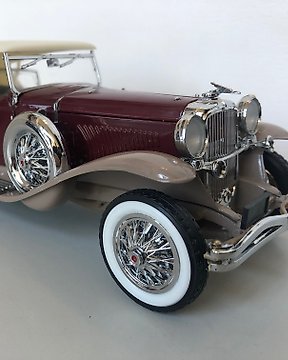
Franklin Mint 1:24 - Modell autó - Duesenberg J Derham Tourster 1930
Nr. 82526717

Nr. 82526717

1930 Duesenberg J Derham Tourster model done by Franklin Mint, Precision Models in 1987.
The first Model J prototype was created in 1927 and the first cars were delivered in 1929, shortly before the onset of the Great Depression. About three hundred Model Js were completed by 1930, short of the original 500-vehicle goal.[22]
Model J engine
The car's 7 L (420 cu in) engine was based on the company's racing engines of the 1920s and was manufactured by another Cord company, Lycoming. It output 265 horsepower (198 kW), aided by dual overhead camshafts and four valves per cylinder, making it the most powerful car of its time.
The Model J was capable of a top speed of 118 mph (190 km/h), and 88 mph (142 km/h) in second gear. Duesenberg historian Randy Ema wrote that the Model J spurred change in engine design, "single-handedly (starting) the horsepower race that drove the number of cylinders from twelve to sixteen," but noted those engines still could not match the Model J's power output.
Only the chassis and engine of the Model J were displayed, as the body and cabin of the car were custom built per custom for luxury vehicles at the time. The company's chief body designer, Gordon Buehrig designed around half of the Model J bodies, while the remainder were designed by coachbuilders around the world, including Gurney Nutting, Murphy, and Derham, among others.
The J was available in two versions of chassis with a different wheelbase; a longer one (153.54 in (3.90 m)) and a shorter one (about 141.73 in (3.60 m)). There were also other special sizes, like the SSJs with a wheelbase shortened to 125 in (3.18 m) and a few cars with the wheelbase extended to 160 in (4.1 m) and over.
The supercharged Model J, referred to as the SJ, was reported to have reached 104 miles per hour (167 km/h) in second gear and have a top speed of 135–140 miles per hour (217–225 km/h) in third gear. Zero-to-60 mph (97 km/h) times of around eight seconds and 0–100 mph (0–161 km/h) in 17 seconds were reported for the SJ despite having an unsynchonized transmission, at a time when even the best cars of the era were not likely to reach 100 mph (160 km/h). The SJ had a wheelbase of 142.5 in (362 cm).[25] The SJ was introduced in 1932. Only 36 units were built.
A special version of the SJ, the Mormon Meteor, broke several land speed records.
Investors in New York City originally supported the Model J, but following the Stock market crash of 1929, the market for Model Js switched to Hollywood stars.
The one-off SJ Twenty Grand was produced in 1933 for the Century of Progress World's Fair to represent Duesenberg's automotive progress.
Two modified Model Js, known as the SSJ, were produced in 1935 for actors Gary Cooper and Clark Gable.
The SSJ reportedly produced 400 hp (298 kW) and could go 0 to 60 mph (0 to 97 km/h) in less than 8 seconds. Cooper's SSJ sold for $22 million in 2018, making it the most expensive American car ever sold at auction at the time.[28] About 378 of 481 Model Js of all types still existed as of 2002.
Hogyan vásárolhatok a Catawiki-n?
1. Fedezzen fel valami különlegeset
2. Tegye meg a legmagasabb licitet
3. Fizessen a biztonságos és védett rendszert használva